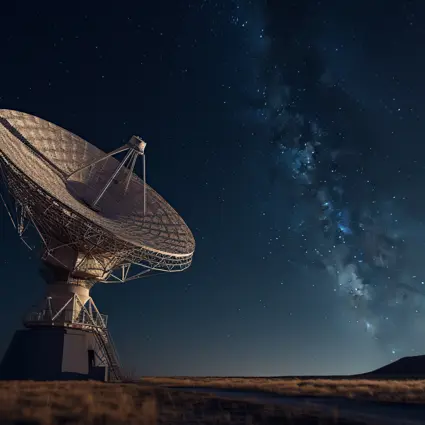Xiao Li was always curious about the mysteries of the universe and dreamt one day she would explore it. Now as a DPhil student at the Oxford e-Research Centre, she is contributing to the Square Kilometre Array project. Her work mainly focuses on developing a new imaging pipeline for radio astronomy.
Exploring the vast and unknown Universe is one of the grandest challenges of humanity. Astronomy, a discipline appearing from ancient times, studies celestial objects and phenomena such as galaxies and cosmic background radiation.
When you gaze up at the night sky, you are engaging in one of the fundamental observations of astronomy. Celestial bodies were observed by the naked eye before the birth of telescopes in the 17th century. In early astrophysics, astronomical optical telescopes enabled people to observe celestial spheres in the visible region of the electromagnetic spectrum.
Many celestial objects in space, such as stars and galaxies, emit radio waves in addition to visible light. When Karl Jansky discovered radio waves from the Milky Way in 1933, the subsequent development of radio detection technology nurtured radio astronomy. Radio astronomy studies celestial phenomena by observing celestial bodies in radio wave bands using radio telescopes. It has various and important applications. For example, radio astronomy can study the cosmic microwave background, cosmic magnetic fields, star and planet formation, neutron stars, and allowing for tests of theories such as general relativity.
Radio astronomy has advanced considerably through the decades with the development of radio telescopes. Radio telescopes receive the radiation from celestial sources by antennas, with the signal enhanced by amplifiers. However, single-aperture radio telescopes are hampered by diffraction effects. The development of radio interferometry overcame this problem. A radio interferometer consists of an array of separate antennas. One of the most famous next-generation radio interferometers is the Square Kilometre Array (SKA), which will achieve very high sensitivity and resolution. The SKA will be the largest radio telescope in the world once completed.
When I was very young, I was always curious about the mysterious Universe and dreamt that one day I could explore it. Now as a DPhil student, under the supervision of Professor Wes Armour in the Oxford e-Research Centre, I am very happy that I can contribute towards the SKA project. My work mainly focuses on developing a new imaging pipeline for radio astronomy.
In an interferometer, the vector that connects the phase centres of two antennas is called a baseline vector. The relationship between observed complex visibilities, which are radio emissions from the sky, and source brightness distribution (SBD) associated with the baseline vector is a ‘Fourier transform.’ Practically, with a limited number of antennas in an array, the number of observation measurements is also limited, even when including the rotation of the Earth. Therefore, the inversion from visibility to image is an ill-posed problem. Consequently, radio interferometric (RI) imaging methods are developed to restore the sky brightness distribution. In other words, with the RI imaging, we will be able to get a more complete image of the Universe. The computational speed is very important when dealing with very large datasets. We are enhancing the imaging pipeline to improve computational speed and sensitivity of source detection.
At the end of the imaging pipeline, we have also developed several new image quality assessment (IQA) methods. Imagine you are looking at two images that are very sparse, with only a few point-like celestial sources. They might appear similar because most of the images are just darkness. However, the differences between those celestial sources are crucial. So, how can you effectively compare the similarity between the two images? When dealing with these low-information radio astronomical images, it is inappropriate to use the traditional IQA methods, such as Structural SIMilarity (SSIM) index, intended to assess the two input images with the perceived quality. Therefore, we have developed InTensity Weighted SSIM Index (ITW-SSIM), Low-Information Similarity Index (LISI), and augmented LISI (augLISI). These state-of-the-art IQA methods can not only be used in radio astronomical imaging, but also wider fields such as medical imaging and with remote sensing data.
I hope that we can make some contributions to the SKA, society, and the exploration of the Universe. There is still a long journey ahead for researchers to delve deeper into this topic. Researchers from diverse cultures, countries, and disciplines are collaborating on this global observatory.
Protecting against brain injuries
Brain Mechanics and Trauma; Computational Mechanics

